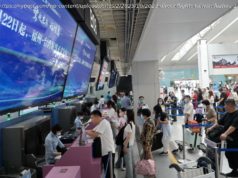Chinese schools are often dismal. Fixing them is the key to long-term growth.
Chinese President Xi Jinping recently laid out a bold vision for transforming his country into a fully developed economy by 2050, with a particular emphasis on spurring innovation and technology. Given China’s current level of human capital — and some looming changes in the world economy — that may be harder than he expects.
A widely held view in the West is that China’s schools are brimming with math and science whizzes, just the kind of students that companies of the future will need. But this is misleading: For years, headline-grabbing studies showing China’s prowess on standardized tests evaluated only kids in rich and unrepresentative areas. When its broader population was included, China’s ranking dropped across all subject areas.
Official data bears out this dynamic. According to the 2010 census, less than 9 percent of Chinese had attended school beyond the secondary level. More than 65 percent had gone no further than junior high. From 2008 to 2016, China’s total number of graduate students actually decreased by 1 percent. Outside the richest areas, much of China’s population lacks even the basic skills required in a high-income economy.
Making matters worse are the millions of children in rural areas who are being raised by their extended families. With their parents working in faraway cities, these children tend to fair much worse in school and on IQ tests. Stanford economist Scott Rozelle has referred to this as an “ invisible crisis “ in the making: In the coming decades, he estimates, some 400 million underprepared Chinese could be looking for work. His research has touched such a nerve that even state media has given it serious coverage.
At the moment, it’s easy to overlook these problems. Official unemployment remains low and stable. Wages are rising and the middle class is expanding. China’s factories still rank among the world’s best, and its workers broadly have the skills they need to support themselves.
Yet with demographic and technological changes accelerating, the education gap will soon loom large. As wages rise, Chinese manufacturers will face growing competition from less-developed countries. As automation improves, factories will need workers with more and better education. And as older industries are disrupted, employers will demand new skill sets.
China — like many countries — isn’t prepared for these changes. Sustaining an advanced, service-based economy isn’t possible when only 25 percent of the working-age population has a high-school degree. In every country that made the jump from middle-income to high-income over the past 70 years, Rozelle found, at least 75 percent of the working-age population had a high school degree before the transition began. Even China’s elite schools can’t drive economic development for 1.4 billion people.
Raising the level of education more broadly will require both investment and reform.
Most countries would benefit from investing more in education. But in China, the need is especially acute: Even in prosperous urban centers, classrooms are commonly crammed with 50 students apiece, forcing much of the actual work of education onto frustrated parents. That’s a recipe for failure.
Another priority should be overhauling the so-called hukou system of household registration. The reason so many children are being raised by their grandparents in rural areas is because they’re restricted from accessing public services — including schools — in the cities where their parents work. Yet it’s significantly easier to offer a quality education in urban centers than in far-flung villages. And with apartment vacancy rates above 20 percent in many cities, it would be both a humane and economically sound policy to end these restrictions.
A final goal should be reforming curriculums. China is famous for requiring rote memorization of its students. But schools are also increasing classwork on communist ideology, Confucian thought and even Traditional Chinese Medicine. The emphasis should instead be on skills — such as creativity and unstructured problem-solving — that will help drive entrepreneurship and innovation, and ensure that students can compete in a world of robots and drones.
Although other countries will face many of these problems in the years ahead, China is starting with some especially severe handicaps. Xi may be right that China’s people are resilient and creative enough to achieve his goals. But the journey will be a rocky one.
This column does not necessarily reflect the opinion of the editorial board or Bloomberg LP and its owners.
To contact the author of this story: Christopher Balding at cbalding@phbs.pku.edu.cn
To contact the editor responsible for this story: Timothy Lavin at tlavin1@bloomberg.net






